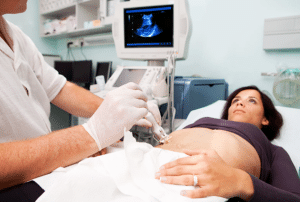Background
Liver ultrasonography, also called liver ultrasound, uses ultrasonic waves to pass through liver tissue to visualize its structure and functions. Sonography is another modality that involves the use of high-frequency sound waves to visualize the liver and the surrounding tissues for the diagnosis and follow-up of different liver diseases.

Liver ultrasonography
Indications
Contraindications
Outcomes
Equipment
Standard Ultrasound Machines
B-mode (Brightness mode)
Doppler Ultrasound
Portable Ultrasound Machines
Elastography Machines:
Transient Elastography (TE)
Shear Wave Elastography (SWE)
3D/4D Ultrasound Machines
Patient Preparation
Patient position
The preferred position is supine.
Left Lateral Decubitus Position: Where a better view of the left lobe of the liver is required, the patient can be slightly rolled to the left side.
Technique
Step 1: Positioning:
The patient is typically placed in a supine position on the examining table. Sometimes, the patient will be asked to turn to their side or sit up to obtain other views.
Step 2: Applying Gel:
A water-based gel will be applied to the abdomen. This gel eradicates air pockets between the skin and the ultrasound transducer, the probe, allowing more explicit transmission of sound waves.
Step 3: Using the Transducer:
The sonographer or radiologist will move the transducer to send high-frequency sound waves into the body. When these sound waves hit the liver and other structures, they bounce off and then are sent back to the transducer.
The transducer will be moved over different areas of the abdomen to obtain different views of the liver.
Step 4: Image Capture:
These are then converted into images, which are real-time and are displayed on a monitor; the sonographer takes these images from various angles and positions to represent an overview of the liver.
Specifically, measurements and observations are done for size, shape, texture and any irregularities such as cysts, tumours or fatty deposits.
Step 5: Analysis
Liver Size and Shape:
Assessment for enlargement, hepatomegaly, or any irregularity of the contour of the liver.
Liver Texture:
Identification of any changes in the echotexture of the liver, which can suggest cirrhosis, fatty liver, or hepatic fibrosis.
Lesion Detection:
Any mass, cyst, or tumor in the liver is identified. Blood flow within the liver may be evaluated with Doppler ultrasound to identify any vascular abnormalities.
Examination of Surrounding Structures
The sonographer examines the surrounding organs, including the gallbladder and bile ducts, pancreas, and blood vessels, for any associated diseases.
Step 6: Post-Procedure:
Preparing the Report
The sonographer collects the images and preliminary reports.
Images taken are then reviewed by a radiologist, after which a detailed report is compiled and sent to the referring physician.
Follow-Up:
The physician may order tests, treatment, or follow-up imaging based on the findings.
Complications
References
References

Liver ultrasonography, also called liver ultrasound, uses ultrasonic waves to pass through liver tissue to visualize its structure and functions. Sonography is another modality that involves the use of high-frequency sound waves to visualize the liver and the surrounding tissues for the diagnosis and follow-up of different liver diseases.

Liver ultrasonography
Standard Ultrasound Machines
B-mode (Brightness mode)
Doppler Ultrasound
Portable Ultrasound Machines
Elastography Machines:
Transient Elastography (TE)
Shear Wave Elastography (SWE)
3D/4D Ultrasound Machines
The preferred position is supine.
Left Lateral Decubitus Position: Where a better view of the left lobe of the liver is required, the patient can be slightly rolled to the left side.
Step 1: Positioning:
The patient is typically placed in a supine position on the examining table. Sometimes, the patient will be asked to turn to their side or sit up to obtain other views.
Step 2: Applying Gel:
A water-based gel will be applied to the abdomen. This gel eradicates air pockets between the skin and the ultrasound transducer, the probe, allowing more explicit transmission of sound waves.
Step 3: Using the Transducer:
The sonographer or radiologist will move the transducer to send high-frequency sound waves into the body. When these sound waves hit the liver and other structures, they bounce off and then are sent back to the transducer.
The transducer will be moved over different areas of the abdomen to obtain different views of the liver.
Step 4: Image Capture:
These are then converted into images, which are real-time and are displayed on a monitor; the sonographer takes these images from various angles and positions to represent an overview of the liver.
Specifically, measurements and observations are done for size, shape, texture and any irregularities such as cysts, tumours or fatty deposits.
Step 5: Analysis
Liver Size and Shape:
Assessment for enlargement, hepatomegaly, or any irregularity of the contour of the liver.
Liver Texture:
Identification of any changes in the echotexture of the liver, which can suggest cirrhosis, fatty liver, or hepatic fibrosis.
Lesion Detection:
Any mass, cyst, or tumor in the liver is identified. Blood flow within the liver may be evaluated with Doppler ultrasound to identify any vascular abnormalities.
Examination of Surrounding Structures
The sonographer examines the surrounding organs, including the gallbladder and bile ducts, pancreas, and blood vessels, for any associated diseases.
Step 6: Post-Procedure:
Preparing the Report
The sonographer collects the images and preliminary reports.
Images taken are then reviewed by a radiologist, after which a detailed report is compiled and sent to the referring physician.
Follow-Up:
The physician may order tests, treatment, or follow-up imaging based on the findings.
Complications

Both our subscription plans include Free CME/CPD AMA PRA Category 1 credits.

On course completion, you will receive a full-sized presentation quality digital certificate.
A dynamic medical simulation platform designed to train healthcare professionals and students to effectively run code situations through an immersive hands-on experience in a live, interactive 3D environment.

When you have your licenses, certificates and CMEs in one place, it's easier to track your career growth. You can easily share these with hospitals as well, using your medtigo app.



